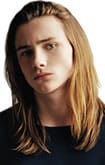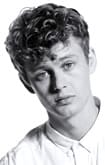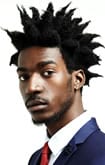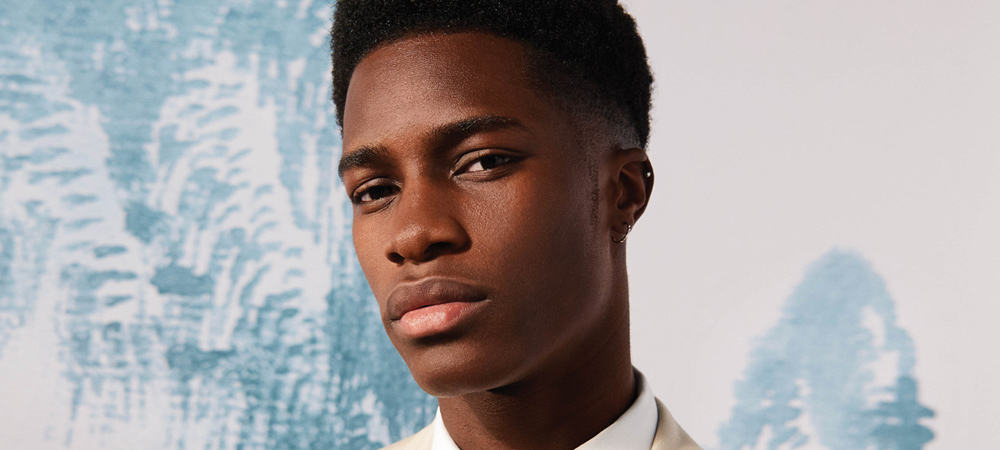Your body is a temple, sure. But so is your head. Or, at least, it has them, so you may as well make the most of them by tapping the latest and greatest tonsorial trickery.
The temple fade is the most recent in a long line of modern barbering techniques to have taken up residence on heads. An ideal low-risk hair manoeuvre, it has a markedly less striking look than other better-established fade haircuts. Nevertheless, worn right, this subtle element can lend a contemporary touch to a wide variety of hairstyles.
All of which males the temple fade something well worth having jotted down in ole mental Rolodex next time it comes to paying your barber a visit. Here’s what you need to take with you.
What Is A Temple Fade?
You don’t have to be Sherlock Holmes to figure out what temple fade might look like. The clue is in the name. “A temple fade is a very specific fade where only the temple area on both sides and the nape area at the back of the head are faded out to a grade below that on the sides,” explains Dan Glass, a senior barber at Murdock London. “This is usually down to a grade below a grade two.”
The subtlety of the temple fade means that it can be used to accompany a vast range of men’s haircuts. “From the choppy look to a slick-back or small pompadour – its is adaptable enough to use with any trim,” adds Joth Davies, owner of Savills barber shop.
Traditionally these classic cuts are worn with a short back and sides, so adding a temple fade into the mix can give any style a modern twist. Making it the perfect choice if you want to rock #throwback hair without looking like you’ve just stepped straight out of the Delorean.

How Did The Temple Fade Become Popular?
So when did this subtle styling detail get so big? Well, it didn’t really. For all it’s plus points, the temple fade is still a relatively little-known barbering flex, and often loses out to its more popular options, such as the drop fade, taper fade or low fade.
The only real mainstream attention the temple fade received was when it was sported by Jersey Shore’s DJ Pauly D as part of his trademark ‘blowout’ hairstyle. Granted, this wasn’t the type of celebrity endorsement likely to get stylish men flocking to their local barber shops, but it was enough to garner this misunderstood cut a bit of recognition.
From there, the blowout style became increasingly popular, especially among guys with afro hair. However, that led to the temple fade being somewhat typecast as only for use with this hair type. But that’s something that’s beginning to change now as people realise the versatility it can offer.
Will It Work For Me?
Before you get too comfortable in the barber’s chair, you need to consider whether or not a temple fade is right for you. “A temple fade is a perfect fade option for those that are new to this type of look and want to proceed with caution – i.e. not over commit to a full fade,” says Davies.
It’s also worth considering whether this type of haircut will suit your face shape. The temple fade is useful for removing weight at the sides of the head, making it a solid option for those with round or square faces who want to keep things closely cropped at the sides while retaining the option of wearing some length on top to elongate the face.
Key Temple Fade Styles And How To Get Them
Temple Fade + Short Crop
Short, cropped haircuts have seen an unprecedented revival in recent years. This is thanks in no small part to Cillian Murphy and his band of Brummie brothers on Peaky Blinders. However, the harsh look of the undercut commonly worn with this style can put some men off. That’s where the temple fade comes in.
“The defining characteristic of this haircut would be a classic front-facing crop with a little added edge,” explains Glass. “The temple fade helps change a crop from the simple short back and sides you had at school into a modern classic. Which is especially fitting given the renaissance of ’90s sportswear styles.”
When visiting the barber, it’s important to stress that you want a temple fade rather than the traditional high fade or disconnected undercut. “It’s also vital to make a distinction between the preferred length on the sides (e.g. #2) and the fade (e.g. #0/0.5/skin),” adds Glass.
When it comes to styling, it couldn’t be easier. “Simply towel dry your hair, apply a touch of matte paste and rake it forward as messy or structured as you like.”

Temple Fade + Pompadour
The pompadour is a cool follicular throwback, but the inclusion of a temple fade adds the finishing touch and helps redefine a retro classic into a timeless men’s hairstyle.
“It looks great with a long-haired pompadour, where the sides are cut with scissors and at least one inch in length, or on a pomp where the sides and back have been clippered down to a grade two, three or even four,” says Glass.
“[The sides] can be either faded down into your beard or through to the end of your sideburns. Again, like a crop, do specify the shortest length you would the fade to go down to.”
Of course, it’s worth remembering that pompadour haircut takes a reasonable amount of styling. “Apply a sea salt spray liberally before blow-drying the sides diagonally back towards the crown, building significant volume through the fringe.” Then finish with some pomade, slicking the hair back to the nape of the neck and combing the fringe back, so it sits neatly on top.

Temple Fade + Short Afro
A temple fade with a short afro makes for a great low-key alternative to the bolder blowout style. It’s also useful for slimming the sides of the face down if your cheeks are a little too round to go full ‘fro.
“The temple fade is contained between the top of the ear and the recession area around the hairline,” explains Tom Chapman, founder of the Lions Barber Collective and ambassador for The Bluebeards Revenge grooming brand. “Meanwhile, the afro is usually kept close to the scalp, which creates shape and structure to give an aesthetically-pleasing silhouette.”
Chapman advises asking your barber for a skin taper or fade in front of both the ears, blending into the hair on top with a clean line up. “An image is always best to show your barber as your ‘short’ may not be your barbers ‘short’.”
Just remember that the shorter the fade, the more frequent visits are required to keep it looking sharp and fresh.

Temple Fade + Slick Back
If you’re looking for a style that looks smart and put together with minimal effort, then this slicked-back ‘do could be just what you’re after.
“Ask your barber to contain the fade to the temple area in front of the ear,” says Chapman. “Then it is blended into the top and back of the head’s hair. Sometimes there may be a little disconnection or overhang from the extra length on the fringe area. Blend it towards the back and leave enough length through the top to slick back with a decrease in length at the nape.
If all that sounds a bit confusing, return to the old faithful trick of taking an image with you. “Create a folder on your phone with different angles, and you will get the haircut you desire,” he adds.
For styling, reach for a foundation product such as a salt spray or volume powder and apply to wet hair before blow-drying it back and into shape. “Finish with a matte paste to ensure you look great until you revisit your barber in about four weeks.”








